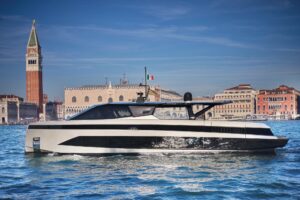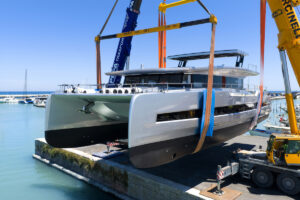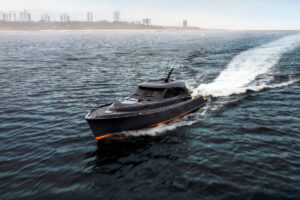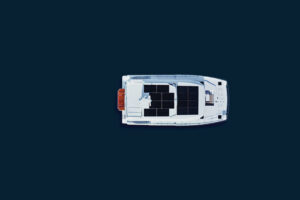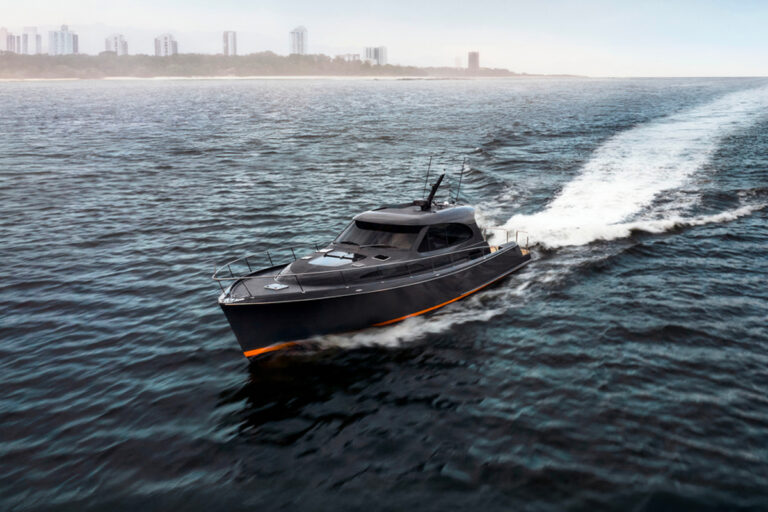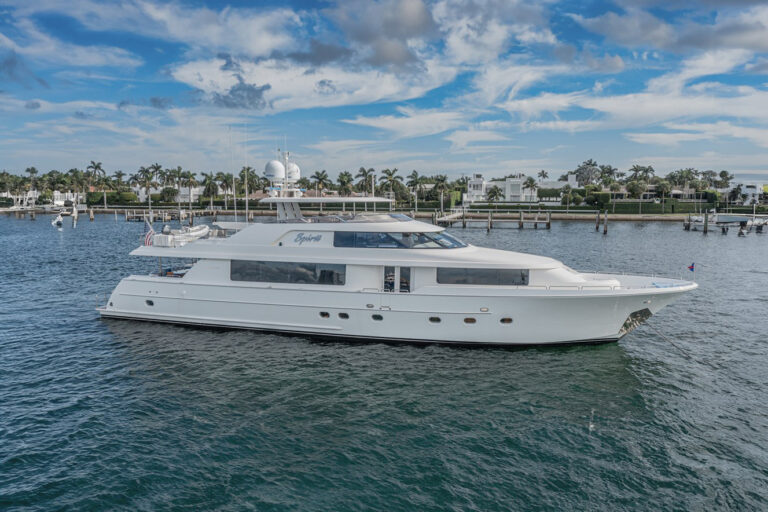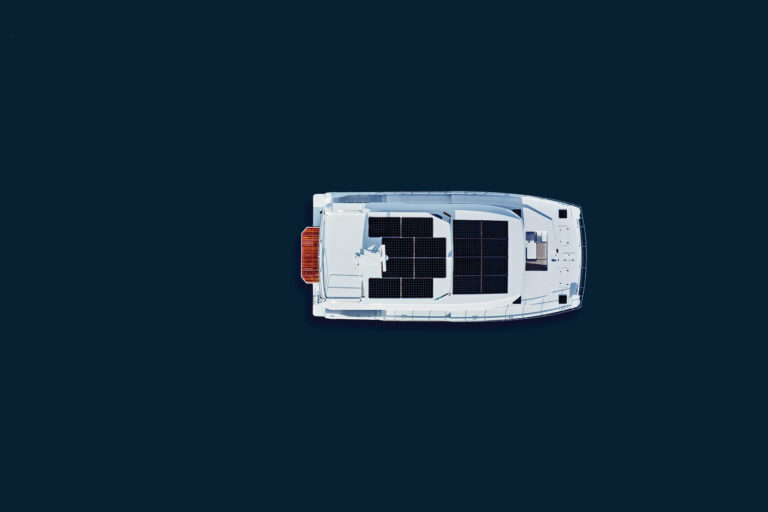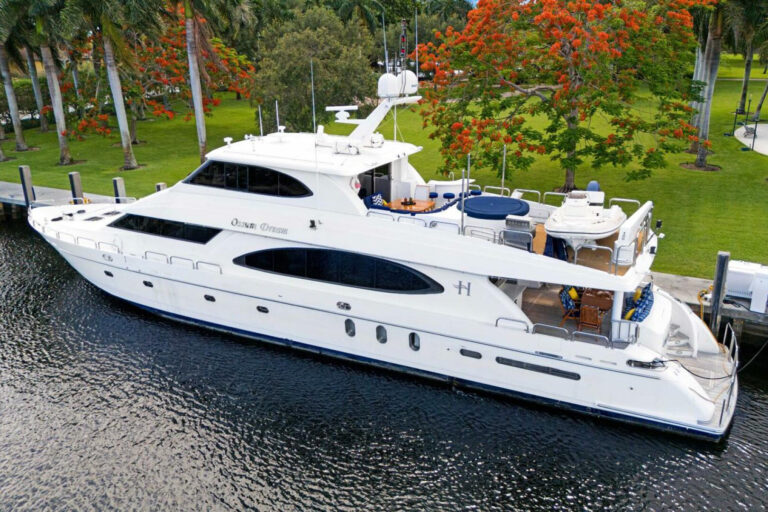Perhaps best known for its classic wooden speedboats, including the renowned Aquarama, Riva has built in fiberglass since 1969 and offers a range of cruising and day yachts up to 84 feet in length. For the cognoscenti, the mere mention of the name Riva conjures images of exceptional yachts, beautiful people and azure waters. The yachts are still built in Sarnico, Italy, on the shores of Lake Iseo, where Peitro Riva first opened his yard in 1842.
Family owned until a few years ago, Riva is now part of the Ferretti Group. The change seems to have brought a new vitality to the marque, giving it the capital to bring out larger yachts such as the Splendida Super, as well as day boats like the new Rivarama, a stunning 44-footer. Riva describes the new 72 as a “cabriolet sports cruiser”. The phrase conjures classic images and beauty, but I wasn’t completely sure how it would translate to a yacht until I spent a few hours on board.
The Splendida’s hull is not stark white, but rather a rich ivory cream that adds to her classic aura. Her cabin top, finished in a muted silver gray, has a skylight and a pair of small opening hatches over the helm area. Just abaft the helm, a larger section of the coachroof slides aft to bring in the sunshine and sea air. The console is a deep royal blue, and the saloon and afterdeck, as well as the swim platform, are teak.
With the top open and running at her cruising speed of 32 knots, there was no disturbing wind, just a hint of breeze throughout the saloon. Even with the after door open, sound levels were low enough for easy conversation at the helm. The cabriolet part of the equation was working well, and I couldn’t wait to try out the sport cruiser part.
After a few subdued runs off Portofino for photos, I got my chance behind the wheel. The Splendida was very responsive to the helm and rudders, and displayed good acceleration throughout her range. Her ride was dry with little spray, but she did exhibit what I’d call her “sport suspension in some choppy seas.
Below the waterline, she runs on a monohedron, or prismatic, planing hull with a relatively moderate deadrise of 14.7 degrees, considerably less than the 20-plus degrees of deep-V boats. The result is higher speed and better fuel economy, but a bit firmer ride.
The Splendida’s MAN diesels turn V-drive gears through short jack shafts, driving submerged props that propelled her to 35.8 knots during our test. This is slightly faster than Riva’s reported top speed of 35.5 knots for an average at-sea condition. In a display of candor and reality that is too rare among builders of fast boats, Riva notes in its sales literature that the Splendida will lose about 1 knot for each 3,300 pounds added. I wish other builders would follow Riva’s lead in acknowledging the inseparable triangle of speed, horsepower and weight.
The forward part of the upper saloon is a delightful exercise is ergonomics. Facing the helm to port are two seats, one of which converts to a bolster. To starboard, a companion seat is fitted with a substantial grab rail and a well-placed foot brace. How often I’ve wished for these on other performance boats as I bounced around, totally at the mercy of some clueless, nay sadistic, captain.
Also in the saloon area abaft the helm is a dinette for six to eight guests. Opposite it, to starboard, is a service and entertainment cabinet that houses a refrigerator, ice maker and television, as well as all the china and glassware. The cabinetry is elm, in a natural finish Riva calls “peach skin. A more apt description could not be found, for it is satiny with just enough bite to render it virtually nonslip to hands and accessories.
Forward, the teak gives way to true nonslip around a large sunpad fitted with holders for drinks and food trays. Stowage lockers for fenders are also provided. Along the side decks, water fills are well forward, i.e. uphill, of the fuel fills to avoid accidental contamination of the water. The window frames are polished stainless steel and mounted flush with the surrounding fiberglass.
The open afterdeck has built-in chairs for two and a table that seats eight, four on a settee and four in deck chairs. Lockers house a wash basin and an optional electric grill. A sunpad abaft the settee lifts to expose a tender garage, and is flanked by two substantial gates guarding the port and starboard stairs to the swim platform. Adjacent to the gates are raised mooring stations that put capstans, chocks and cleats at working height under a hinged cover.
Also on the afterdeck are the operators for the engineroom fire extinguishing system. The pull handles are painted bright red-no camouflage here-and mounted behind a clear cover, locked but easily breakable, to prevent accidental activation by curious children. The crew cabin is accessed by a scuttle to starboard, and the engineroom via a flush hatch in the deck.
A short, straight stairway, open to the upper saloon and flooded with light from the windshield above, leads to the lower saloon and galley. Here, the teak sole gives way to carpet, and elm and upholstered panels replace the fiberglass bulkheads. In the overhead, a large semi-transparent skylight brings in natural light without compromising privacy.
Layout and equipment in the galley are excellent. The stainless-steel refrigerator and freezer have substantial latches on the doors, and keepers are fitted to the shelves inside. The cooktop is equipped with sea rails, something found too seldom on motoryachts.
A VIP cabin is forward, with an island double berth on centerline. The guest head is larger than usual to allow space for a standard bidet. A hatch over the berth provides air and escape.
Standard arrangement is two staterooms, with the master spanning the beam abaft the lower saloon. There are double hanging lockers, a settee to port and a vanity/desk to starboard. The adjacent day head is also accessible from the master for use as a “his head when no day guests are aboard.
An optional three-stateroom arrangement steals space from the master stateroom for upper and lower berths. The master’s settee and vanity are eliminated, and the day head becomes proprietary to the guest cabin.
In either arrangement, a crew cabin with upper and lower berths is next to the engineroom bulkhead to starboard, opposite the master head. While there was no discernable vibration during my sea trial, a slight bit of whine from the V-drive gears was audible in both of these rooms.
Contact: eMarine, (800) 550-3500; www.riva-yacht.com, www.emarine.com.

